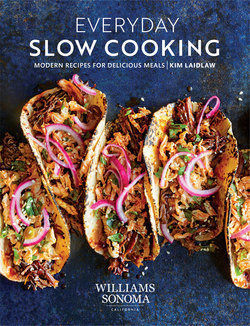Читать книгу Everyday Slow Cooking - Kim Laidlaw - Страница 9
На сайте Литреса книга снята с продажи.
Оглавление8
Prep all of the ingredients in the recipe before you start cooking. You might even prep them the night before to make putting the dish together in the morning even easier (just keep them covered in the fridge overnight). Cut vegetables like carrots, potatoes, cauliflower, or butternut squash into equal-size chunks—usually around 1 inch (2.5 cm) or so—to ensure even cooking.
Brown meat like chuck roast or pork shoulder in oil or butter before adding it to a slow cooker. This builds favor by caramelizing the exterior of the meat and adds rich color to the finished dish. The same goes for sautéing vegetables like onions until golden brown, toasting spices until fragrant, or starting sauces in a frying pan (or the stove top–safe insert of a slow cooker), all of which help transform the ingredients and jump-start the cooking process.
Degaze your stove-top pan with broth, wine, beer, vinegar, or another liquid favor enhancer after browning the meat to release any caramelized meat juices or browned bits stuck to the pan bottom. This simple step helps maximize the favor of a dish.
Walk away once you’ve covered the slow cooker, as recipes typically don’t need additional tending. In fact, most recipes come out better if you leave the lid undisturbed during cooking so the heat stays consistent. Occasionally a recipe will call for one or two brief stirs during cooking, if possible, to ensure even doneness.
Skim the fat, shred the meat, and reduce the sauce. Taking a few minutes to finish a dish can make a big difference in both its taste and its appearance. Skim off as much fat as possible from the top of the cooking liquid using a arge metal spoon. If you will be shredding or chopping the meat or poultry, transfer it to a cutting board and remove any bones, skin, gristle, or arge bits of fat before you shred or chop. To perfect the sauce, strain the cooking liquid through a fine-mesh sieve, let stand for a few minutes to allow any fat to rise to the surface, and then skim off the fat. Simmer the strained liquid in a pan on the stove top until it thickens slightly, then spoon it over the finished dish.
STORING MEALS
I love the fact that a single slow cooker recipe usually makes enough for a full family meal and still leaves ample remaining for leftovers. Braised meats and poultry, soups, stews, and chilis will keep well in the freezer. Plan to serve beans, grains, vegetables, seafood, and desserts the day they are made, or store them in the refrigerator for serving again later in the week (usually within 3 to 5 days).
To store food in the freezer, let the food cool to room temperature, then transfer to an airtight, freezer-safe container. Make sure to label the meal, including the date it was prepared, and then store in the freezer for up to 3 months.
MAKINGMEMORABLEMEALS
The great thing about a slow cooker—and why I use mine often—is that you can add your ingredients and then leave the house while the food cooks. Through trial and error, I’ve found that a little additional prep goes a long way toward achieving superior results. This is not a “dump it all in and walk away” kind of book. While I’ve done my best to keep the recipes simple for today’s busy lifestyle, I have also made sure that the dishes will become favorites of everyone at your table. A few extra minutes spent browning meat and vegetables on the stovetop before adding them to a slow cooker, for example, results in a rich brown crust on meat and can build the foundation for a sauce that will add a ton of flavor to the finished dish. Here are some more tips that will help ensure standout meals.
